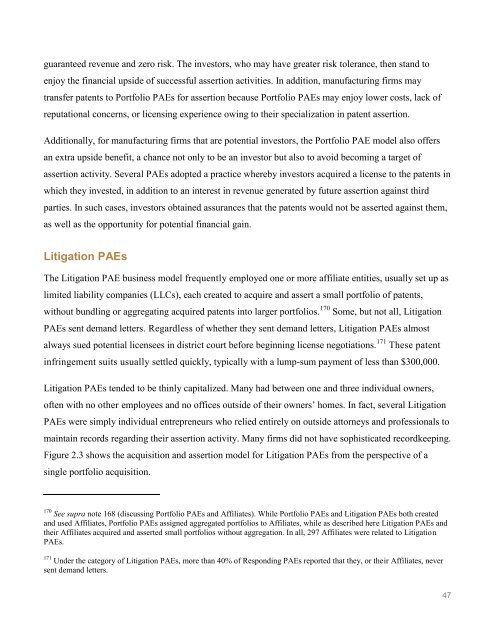Create successful ePaper yourself
Turn your PDF publications into a flip-book with our unique Google optimized e-Paper software.
guaranteed revenue and zero risk. The investors, who may have greater risk tolerance, then stand to<br />
enjoy the financial upside of successful assertion activities. In addition, manufacturing firms may<br />
transfer patents to Portfolio PAEs for assertion because Portfolio PAEs may enjoy lower costs, lack of<br />
reputational concerns, or licensing experience owing to their specialization in patent assertion.<br />
Additionally, for manufacturing firms that are potential investors, the Portfolio PAE model also offers<br />
an extra upside benefit, a chance not only to be an investor but also to avoid becoming a target of<br />
assertion activity. Several PAEs adopted a practice whereby investors acquired a license to the patents in<br />
which they invested, in addition to an interest in revenue generated by future assertion against third<br />
parties. In such cases, investors obtained assurances that the patents would not be asserted against them,<br />
as well as the opportunity for potential financial gain.<br />
Litigation PAEs<br />
The Litigation PAE business model frequently employed one or more affiliate entities, usually set up as<br />
limited liability companies (LLCs), each created to acquire and assert a small portfolio of patents,<br />
without bundling or aggregating acquired patents into larger portfolios. 170 Some, but not all, Litigation<br />
PAEs sent demand letters. Regardless of whether they sent demand letters, Litigation PAEs almost<br />
always sued potential licensees in district court before beginning license negotiations. 171 These patent<br />
infringement suits usually settled quickly, typically with a lump-sum payment of less than $300,000.<br />
Litigation PAEs tended to be thinly capitalized. Many had between one and three individual owners,<br />
often with no other employees and no offices outside of their owners’ homes. In fact, several Litigation<br />
PAEs were simply individual entrepreneurs who relied entirely on outside attorneys and professionals to<br />
maintain records regarding their assertion activity. Many firms did not have sophisticated recordkeeping.<br />
Figure 2.3 shows the acquisition and assertion model for Litigation PAEs from the perspective of a<br />
single portfolio acquisition.<br />
170<br />
See supra note 168 (discussing Portfolio PAEs and Affiliates). While Portfolio PAEs and Litigation PAEs both created<br />
and used Affiliates, Portfolio PAEs assigned aggregated portfolios to Affiliates, while as described here Litigation PAEs and<br />
their Affiliates acquired and asserted small portfolios without aggregation. In all, 297 Affiliates were related to Litigation<br />
PAEs.<br />
171<br />
Under the category of Litigation PAEs, more than 40% of Responding PAEs reported that they, or their Affiliates, never<br />
sent demand letters.<br />
47


